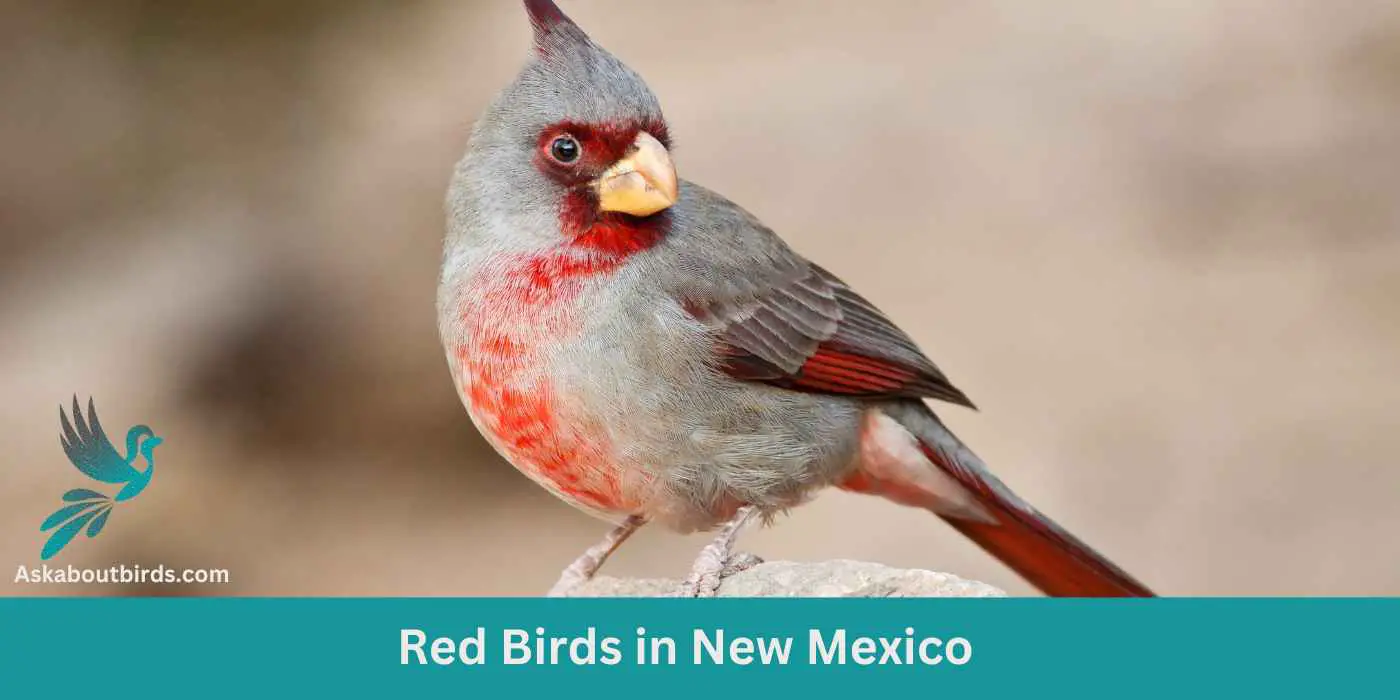New Mexico, often referred to as the ‘Land of Enchantment,’ carries its magic not just in its captivating landscapes, but also in its skies—filled with a colorful array of avian wonders. Among them, the fiery red birds stand out, painting the horizons with their vivacious hues.
Journey with us through our specially crafted guide and get a close look at the 16 spectacular red birds that make New Mexico their home.
Red Birds Found In New Mexico
Nestled in the heart of the American Southwest, New Mexico’s geographical richness provides an ideal backdrop for avian life. The state boasts a diverse terrain, from sun-kissed deserts to rugged mountains and expansive plains.
The state’s varied habitats, dictated by its altitude differences, seasonal river flows, and desert-to-forest transitions, attract a myriad of bird species. These areas act as both permanent residences and stopovers during migratory paths.
Northern Cardinal


| Feature | Measurement |
|---|---|
| Scientific Name | Cardinalis cardinalis |
| Length | 8.3 – 9.1 in |
| Wingspan | 9.8 – 12.2 in |
| Weight | 1.19 – 2.29 oz |
The Northern Cardinal is an iconic North American bird, easily recognized by its vibrant color and melodious song.
Appearance: Male Northern Cardinals are a brilliant scarlet red, while females display a more subdued reddish olive. Both sexes have a distinctive black ‘mask’ on their face around the bill and a pointed crest on their head. The bird’s beak is robust, cone-shaped, and bright orange in color.
Diet: Northern Cardinals are primarily granivorous, with a diet largely consisting of seeds and grains. They also eat fruits and insects. These birds typically feed off the ground and are frequent visitors to bird feeders.
Reproduction: Northern Cardinals are monogamous, and a pair will breed together for life. The female typically builds a well-hidden nest in a dense thicket or shrub. She lays 2-5 eggs per clutch, which she incubates for around two weeks.
Summer Tanager


| Feature | Measurement |
|---|---|
| Scientific Name | Piranga rubra |
| Length | 6.7 in |
| Wingspan | 28 to 30 cm |
| Weight | 29 g |
The Summer Tanager is a medium-sized songbird admired for its radiant plumage and melodious song.
Appearance: Male Summer Tanagers are an impressive bright red, while females and juveniles present a softer, yellow-orange color. Both genders have a large, slightly hooked bill and relatively short tail.
Diet: Summer Tanagers primarily feed on insects, including bees and wasps, which they catch in flight or pick off vegetation. They are also known to eat fruits and berries, making them helpful in controlling pest populations and seed dispersal.
Reproduction: The female Summer Tanager builds a loose, shallow cup-shaped nest out of twigs and grass, usually hidden in the foliage of trees. The female typically lays 3-5 eggs, which she will incubate for about two weeks.
Vermilion Flycatcher
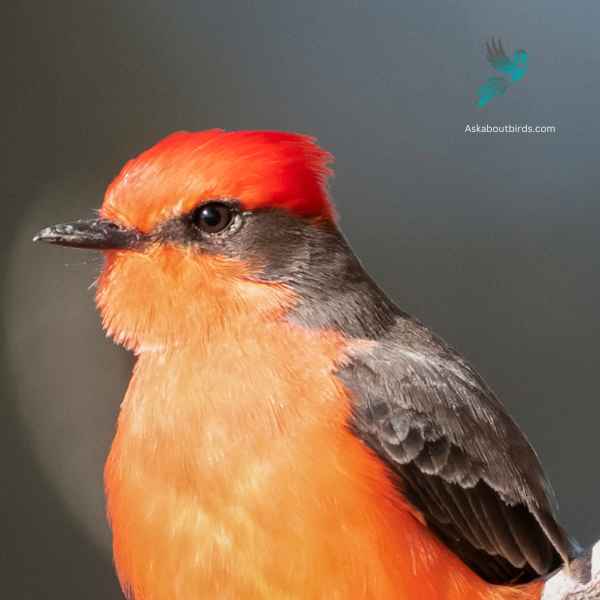

| Feature | Measurement |
|---|---|
| Scientific Name | Pyrocephalus obscurus |
| Length | 5.1–5.5 in |
| Wingspan | 9.4 to 9.8 in |
| Weight | 11 to 14 g |
The Vermilion Flycatcher is a small and colorful bird native to the Americas. The male Vermilion Flycatcher is a striking sight, displaying a vibrant red plumage on its head, breast, and underparts, contrasting with its brown wings and black tail below. Females, on the other hand, have more muted colors, featuring a pale yellowish belly and grayish-brown upperparts.
Vermilion Flycatchers are known for their lively and acrobatic flight displays, which they perform during courtship or to defend their territories. They often sing a series of soft, whistled notes while engaged in these aerial displays. They construct cup-shaped nests, usually in shrubs or low trees, where females lay their eggs and raise their young.
Pyrrhuloxia

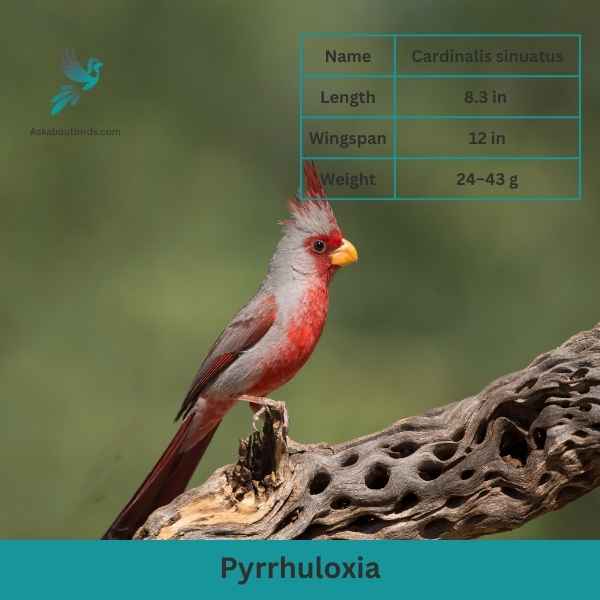
| Feature | Measurement |
|---|---|
| Scientific Name | Cardinalis sinuatus |
| Length | 8.3 in |
| Wingspan | 12 in |
| Weight | 24–43 g |
The Pyrrhuloxia, also known as the Desert Cardinal, is a medium-sized songbird native to the southwestern United States and northern Mexico. It is closely related to the Northern Cardinal but possesses its own unique characteristics. The Pyrrhuloxia is named after its vibrant red crest and mask-like face markings, similar to that of the Northern Cardinal. However, its overall coloration is more muted, with a grayish body and reddish wings and tail.
Pyrrhuloxias are known for their distinct vocalizations, which include a variety of songs and calls. Males often sing from elevated perches to defend their territories and attract mates. They also engage in aggressive displays to establish dominance.
House Finch


| Feature | Measurement |
|---|---|
| Scientific Name | Haemorhous mexicanus |
| Length | 5–6 in |
| Wingspan | 8–10 in |
| Weight | 0.6–0.9 oz |
The House Finch is a small songbird widely distributed across North America and is commonly found in urban and suburban areas.
Appearance: Males of this species are brightly colored with crimson faces and throats, which can extend to the chest and back, while their flanks have streaks. The female is streaked brown and lacks the red coloring. Both have a square-tipped tail and a distinctively long, flat-topped bill.
Diet: House Finches primarily eat seeds, grains, and berries. They have a particular fondness for sunflower seeds and can be commonly seen at bird feeders. Occasionally, they will also consume insects, especially during the breeding season.
Reproduction: House Finches are cavity-nesters and might choose ledges, vents, ledges, and other urban settings. They might also utilize trees or shrubs. Their nests can be made of a wide array of materials, from feathers to twigs.
Cassin’s Finch

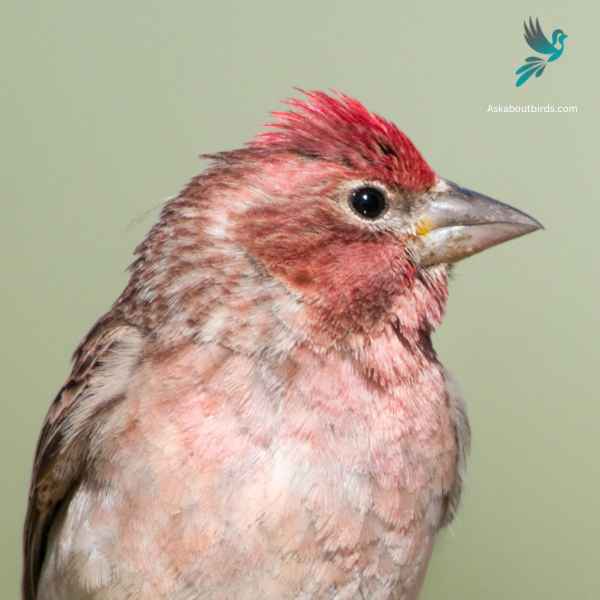
| Feature | Measurement |
|---|---|
| Scientific Name | Haemorhous cassinii |
| Length | 6.0-6.5 in |
| Wingspan | 9.5-10.5 in |
| Weight | 0.8-1.0 oz |
The Cassin’s Finch is a small songbird known for its melodic song and affinity for high-elevation forests.
Appearance: Male Cassin’s Finches are pinkish-red on the crown and throat, contrasting with their streaked brown back and wings. Females lack the bright coloring, appearing streaked brown throughout with a pale eyebrow stripe. Both sexes have a notched tail and a slightly curved bill.
Diet: Cassin’s Finches mainly feed on seeds, particularly from conifers. They also eat insects, especially during the breeding season. Their feeding habits often bring them to bird feeders where they readily eat sunflower seeds.
Reproduction: Cassin’s Finches nest in trees, preferring coniferous forests. The nest is made from twigs, grasses, and feathers. Typically, the female lays 3 to 5 eggs and handles most of the incubation. Both parents partake in feeding the fledglings once they hatch.
Hepatic Tanager
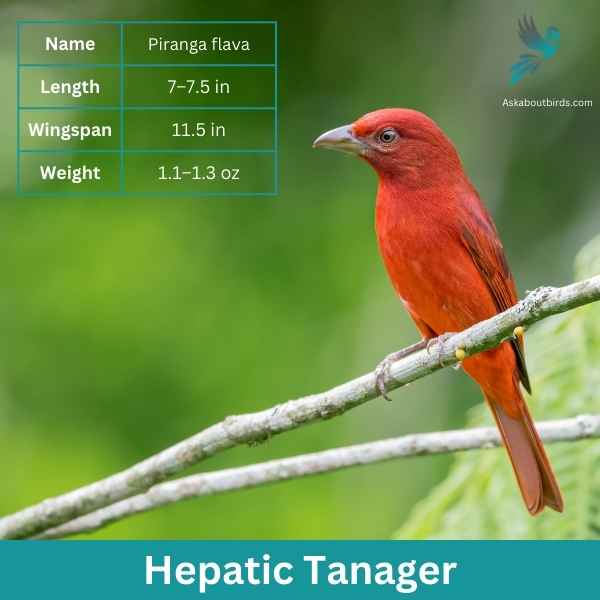
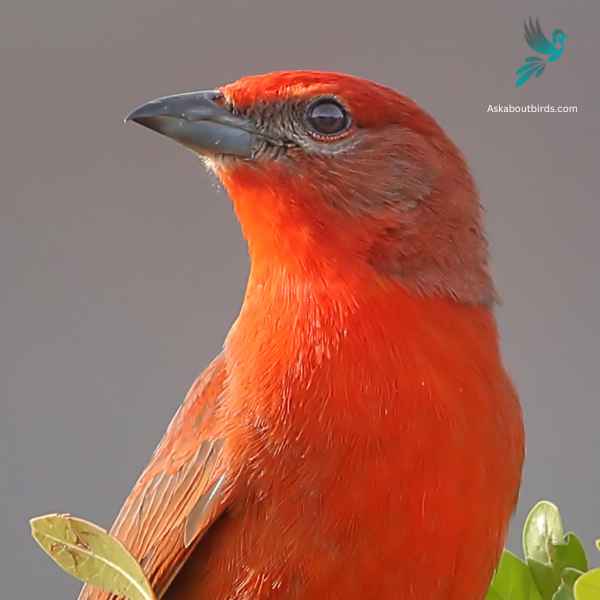
| Feature | Measurement |
|---|---|
| Scientific Name | Piranga flava |
| Length | 7–7.5 in |
| Wingspan | 11.5 in |
| Weight | 1.1–1.3 oz |
The Hepatic Tanager is a robust and brightly colored songbird found primarily in pine-oak woodlands of the American Southwest and Mexico.
Appearance: Male Hepatic Tanagers are a rich reddish-brown or “liver” color, from which they get their name (hepatic means liver-colored). Their wings and tail are more dusky, while females are a more muted yellow-orange, with a gray back and wings. Both sexes have a stout, pointed bill.
Diet: These tanagers primarily eat insects, but they also consume a fair amount of fruit and berries. They often forage by perching quietly and then making short flights to capture prey or pluck fruit.
Reproduction: Hepatic Tanagers nest in trees, often in a concealed location such as a dense clump of needles in a pine tree. The nest is a shallow cup made of twigs, grass, and pine needles. The female typically lays a clutch of 3 to 4 pale blue or greenish eggs. Both parents share feeding duties once the eggs hatch.
Red Crossbill

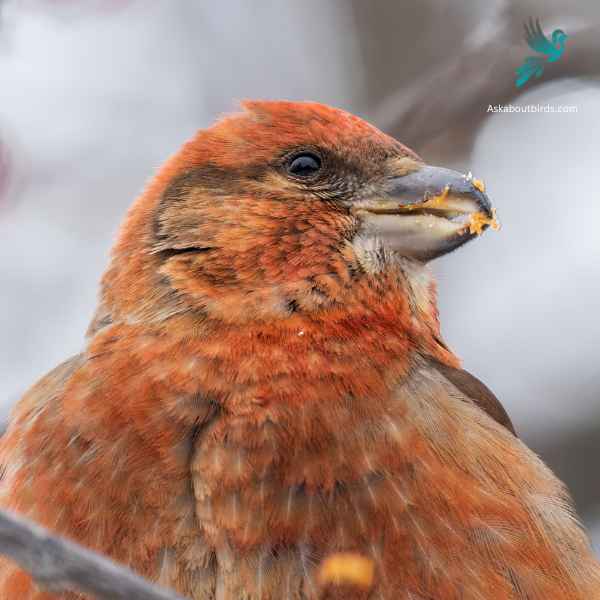
| Feature | Measurement |
|---|---|
| Scientific Name | Loxia curvirostra |
| Length | 5.5–7.5 in |
| Wingspan | 9.8–10.6 in |
| Weight | 0.9–1.4 oz |
The Red Crossbill is a distinctive finch known for its unusual bill, which has evolved to extract seeds from conifer cones.
Appearance: Males are typically bright red or orange, while females are greenish-yellow or olive. Both genders have the characteristic crossed bill, which they use to expertly extract seeds from tightly closed conifer cones.
Diet: Red Crossbills primarily feed on the seeds of coniferous trees, such as spruce, pine, and fir. Their specialized bills allow them to efficiently pry apart conifer cone scales to access the seeds.
Reproduction: Red Crossbills are somewhat nomadic and don’t adhere to a strict breeding schedule. Instead, they breed whenever and wherever food is abundant. Their nests are usually built on horizontal branches of conifer trees.
Common Redpoll

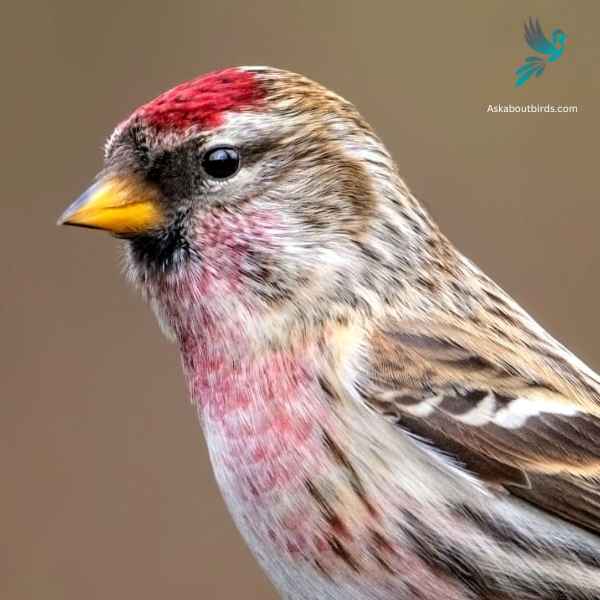
| Feature | Measurement |
|---|---|
| Scientific Name | Acanthis flammea |
| Length | 5.0-5.5 in |
| Wingspan | 7.5-8.5 in |
| Weight | 0.4-0.9 oz |
The Common Redpoll is a small songbird that is easily identifiable by its rosy-red forehead, black chin, and often fluttering flight pattern.
Appearance: Common Redpolls exhibit a distinctive rosy-red forehead patch and black chin. The males typically have a more extensive pink wash on their chest and face than females. The rest of their body is primarily streaked brown and white, with two white wing bars and a notched tail.
Diet: The diet of the Common Redpoll predominantly consists of seeds, particularly from birches and alders. They have a specialized throat pouch where they can temporarily store seeds, allowing them to consume them later in a more sheltered location.
Reproduction: Common Redpolls nest in shrubs or on the ground, using grasses, twigs, and feathers for construction. The female is responsible for the majority of the incubation and typically lays a clutch of 4 to 6 eggs. After the eggs hatch, both parents take part in feeding the young.
Red-Winged Blackbird
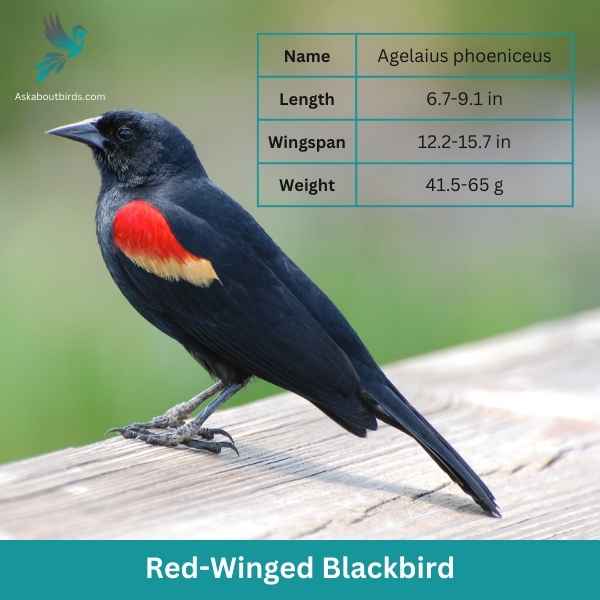
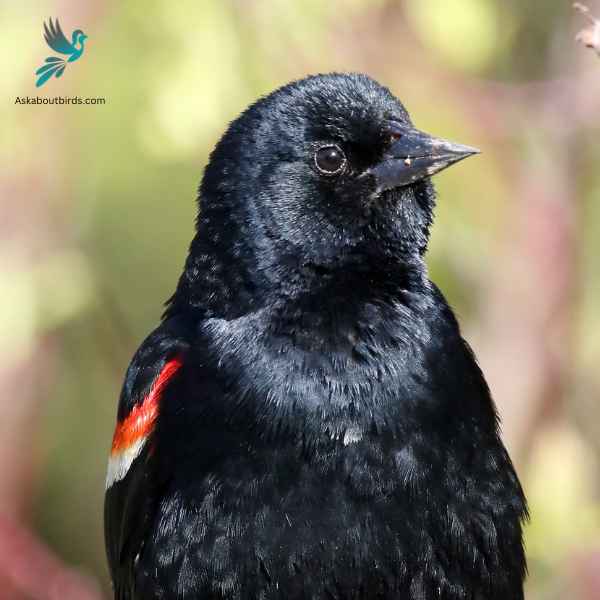
| Feature | Measurement |
|---|---|
| Scientific Name | Agelaius phoeniceus |
| Length | 6.7-9.1 in |
| Wingspan | 12.2-15.7 in |
| Weight | 41.5-65 g |
The Red-Winged Blackbird is a familiar sight across North America, especially in wetlands and open areas. Known for its striking coloration and distinct call, it is often seen perched on cattails or utility lines.
Appearance: Male Red-Winged Blackbirds are glossy black with bright red-and-yellow shoulder patches, while females are streaky brown, resembling a large sparrow. The males’ red patches become more prominent when they’re displaying or agitated.
Diet: Red-Winged Blackbirds primarily feed on seeds and insects. Their diet includes grains, sunflower seeds, and corn, but they also eat beetles, caterpillars, and other small invertebrates, especially in the breeding season.
Reproduction: Red-Winged Blackbirds nest in marshes, along watercourses, and in wet fields. The female constructs a cup-shaped nest using grass and sedge, attaching it to plants above water. She typically lays a clutch of 3 to 4 blue-green eggs, which she incubates for about 11-12 days. Males, being polygynous, often have multiple mates during a single breeding season.
Red-faced Warbler
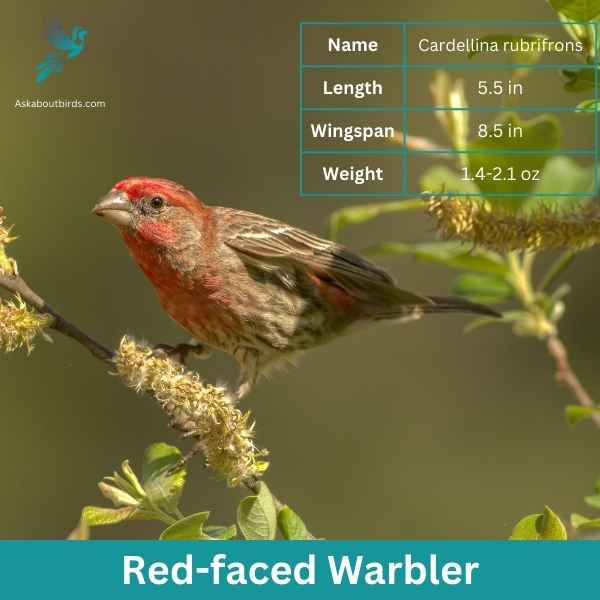

| Feature | Measurement |
|---|---|
| Scientific Name | Cardellina rubrifrons |
| Length | 5.5 in |
| Wingspan | 8.5 in |
| Weight | 1.4-2.1 oz |
The Red-faced Warbler is a vibrant and lively songbird recognized for its stark contrast between its bright red face and its cool-toned body.
Appearance: The Red-faced Warbler is characterized by its bright red face, extending from its forehead to its throat. Its crown and nape are black, creating a striking contrast. The rest of its body is predominantly gray with white undersides, and the birds have a pair of white wing bars.
Diet: This warbler mainly feeds on insects and spiders. They actively forage in the tree canopy and, on occasion, on the forest floor, picking off prey from leaves, twigs, and bark.
Reproduction: Red-faced Warblers nest on the ground, hidden beneath shrubs or other vegetation. The nests are crafted using grasses, pine needles, and other fine materials, and lined with feathers.
Rufous Hummingbird


| Feature | Measurement |
|---|---|
| Scientific Name | Selasphorus rufus |
| Length | 3.1–3.9 in |
| Wingspan | 4.3 in |
| Weight | 0.1–0.2 oz |
The Rufous Hummingbird is a small, brilliantly colored bird known for its impressive migratory journeys and feisty behavior.
Appearance: The male Rufous Hummingbird boasts a gleaming orange-red body with a white chest and an iridescent red throat, called a gorget. The female has green upperparts with rufous-washed flanks and tail. Her throat may have some iridescent patches, but it’s generally whitish.
Diet: Like other hummingbirds, the Rufous Hummingbird primarily feeds on nectar from a variety of flowering plants. They also eat insects and spiders for protein, catching them in flight or plucking them from vegetation.
Reproduction: Rufous Hummingbirds nest in trees, shrubs, or even ferns. The female alone selects the site, builds the nest, and cares for the offspring.
Red-naped Sapsucker


| Feature | Measurement |
|---|---|
| Scientific Name | Sphyrapicus nuchalis |
| Length | 7.5-8.5 in |
| Wingspan | 16 in |
| Weight | 1.2-1.7 oz |
The Red-naped Sapsucker is a medium-sized woodpecker commonly found in forests across the western North America, especially in mixed coniferous woods and aspen groves.
Appearance: This woodpecker is distinguished by its black-and-white barred pattern on the back and wings. A key feature is the bright red patch on the back of the head, which gives the bird its name. Both sexes have a white stripe down the side of the face, though males have a red patch on the throat, whereas females have a white one.
Diet: Red-naped Sapsuckers are named for their habit of drilling rows of shallow holes into tree bark to feed on sap and the insects attracted to it. They also consume ants, beetles, and caterpillars, and will sometimes eat fruits and berries.
Reproduction: These woodpeckers excavate nest cavities in trees, often selecting dead or decaying trees or limbs. After carving out a cavity, the female typically lays a clutch of 4 to 7 eggs. Both parents share responsibilities for incubation and feeding the chicks once they hatch.
Pine Grosbeak

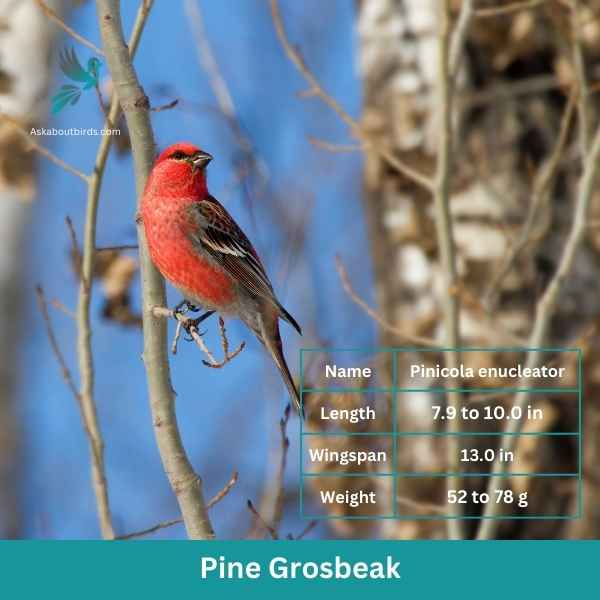
| Feature | Measurement |
|---|---|
| Scientific Name | Pinicola enucleator |
| Length | 7.9 to 10.0 in |
| Wingspan | 13.0 in |
| Weight | 52 to 78 g |
The Pine Grosbeak is a striking bird native to the northern regions of North America, often found in coniferous forests. Both males and females have a plump and robust body with a large beak adapted for eating seeds. The male Pine Grosbeak displays a vibrant reddish-pink plumage, while the female has a more subdued grayish-brown coloration.
These birds are typically seen in small flocks, foraging for food in trees and on the ground. They have a preference for seeds, particularly those from various conifer species. The Pine Grosbeak uses its strong bill to crack open the cones of tall trees and extract the seeds, but they also consume berries and small fruits when available.
Western Tanager

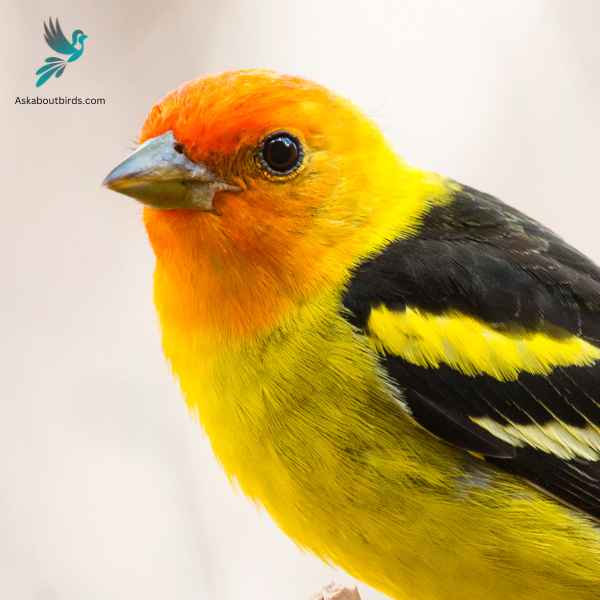
| Feature | Measurement |
|---|---|
| Scientific Name | Piranga ludoviciana |
| Length | 6.3-7.5 in |
| Wingspan | 11.5 in |
| Weight | 24-36 g |
The Western Tanager is a vibrant songbird that graces the forests and woodlands of the western regions of North America, enchanting observers with its colorful plumage and melodious song.
Appearance: The male Western Tanager is renowned for its bright yellow body contrasted with a striking red head and black wings and tail. The females are more subdued in hue, primarily being yellow with grayish wings and back, and lacking the brilliant red head of the males.
Diet: Western Tanagers primarily feed on insects, especially when breeding, but they also incorporate a significant amount of fruits and berries into their diet, especially during migration and winter.
Reproduction: Western Tanagers build their nests high in coniferous trees, often well concealed from potential predators. The female usually lays a clutch of 3 to 5 eggs and takes the primary role in incubation, while both parents are involved in feeding the chicks after they hatch.
Broad-tailed Hummingbird
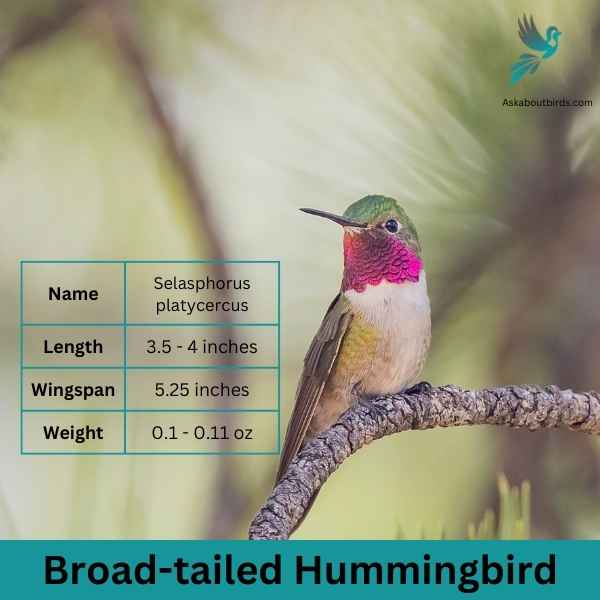
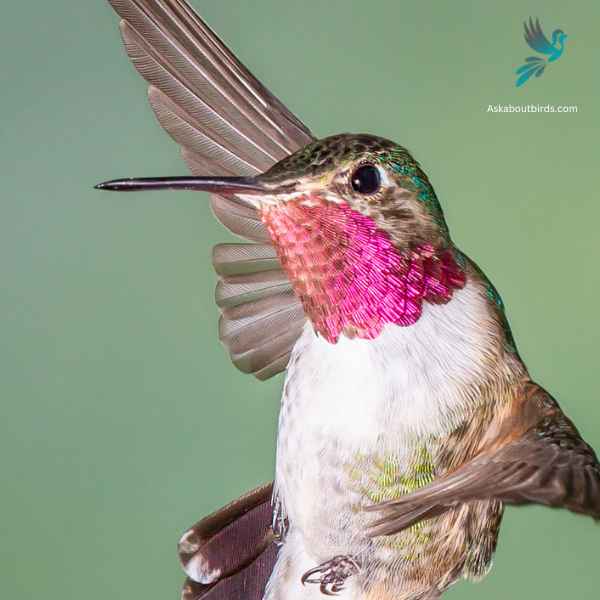
| Feature | Measurement |
|---|---|
| Scientific Name | Selasphorus platycercus |
| Length | 3.5 – 4 inches |
| Wingspan | 5.25 inches |
| Weight | 0.1 – 0.11 oz |
The Broad-tailed Hummingbird is a lively, small bird, identifiable by its iridescent colors and rapid wingbeats, often seen flitting around mountain meadows and gardens.
Appearance: This hummingbird showcases a dazzling green upper body, which in the right light, flashes with brilliant iridescence. Males possess a ruby-red throat, while females exhibit white underparts with green flanks and a white-tipped tail.
Diet: As nectar specialists, Broad-tailed Hummingbirds hover over flowers to sip nectar, acting as pollinators in the process. Additionally, their diet includes small insects and spiders, which provide necessary proteins.
Reproduction: The female is solely responsible for nest construction, which is often secured on a tree branch. This tiny cup-like nest is intricately woven using plant materials and spider webs, then adorned with lichens for camouflage. Inside, she lays typically two white eggs, then incubates and raises the chicks without any assistance from the male.
Where to Spot New Mexico’s Red Birds
New Mexico’s diverse landscapes are a treasure trove for bird enthusiasts, with certain locales standing out as avian paradises.
- Bosque del Apache National Wildlife Refuge: Situated south of Socorro, this refuge is a crucial stop for migratory birds, especially during the winter months. Its wetlands shimmer with the colors of thousands of cranes, geese, and vibrant red birds.
- Gila National Forest: Spanning over 3 million acres, this forest in southwest New Mexico is a haven for bird species due to its varied habitats. From hummingbirds to tanagers, the diversity here is truly remarkable.
- Valle de Oro National Wildlife Refuge: Located just a few minutes from downtown Albuquerque, this refuge is an urban birding hotspot. Its fields and wetlands attract numerous species, including many red birds.
- Carlsbad Caverns National Park: Beyond its famous underground wonders, the park’s desert landscapes and canyons are teeming with birdlife, making it an exciting place for spotting varied species.
- Bitter Lake National Wildlife Refuge: Near Roswell, this refuge boasts rare habitats like sinkholes and gypsum springs, drawing an array of bird species, particularly during migration seasons.
| State’s Red Birds | Top Spots for Red Birds |
|---|---|
| Arizona’s Red birds | 1. Ramsey Canyon Preserve 2. Saguaro National Park 3. Chiricahua National Monument |
| Utah’s Red birds | 1. Bear River Migratory Bird Refuge 2. Zion National Park 3. Fish Springs National Wildlife Refuge |
| Colorado’s Red birds | 1. Barr Lake State Park 2. Rocky Mountain National Park 3. Pawnee National Grassland |
| Oklahoma’s Red birds | 1. Wichita Mountains Wildlife Refuge 2. Red Slough Wildlife Management Area 3. Great Salt Plains State Park |
| Texas’s Red birds | 1. High Island 2. Aransas National Wildlife Refuge 3. South Padre Island |
FAQs on Red Bird Species Found in New Mexico
Why are black oil sunflower seeds popular at backyard feeders?
Black oil sunflower seeds are a favorite among wild birds in new, and are commonly found in backyard feeders across the northern and western states. Their high fat content provides essential energy for birds, especially during colder months. Birds like the purple finch, with its red crown and darker gray wings below, are particularly drawn to these seeds, making them a top choice for bird enthusiasts.
What are the distinguishing features of scarlet tanagers?
Scarlet tanagers are medium-sized birds known for their vibrant coloration. Male scarlet tanagers boast bright red birds with dark gray to black wings, while females exhibit a bright yellow-green plumage with brown coloring on the wings. These birds, native to mixed forests of the eastern and southern states, and eastern states and southern states, often frequent forest edges and canopies, adding a splash of color to the green backdrop.
Where can one find painted buntings?
Painted buntings, with their captivating mix of bright blue heads, green wings, and vibrant red breasts, predominantly inhabit areas of Central and South America. However, they can also be seen in southern Florida and the Caribbean islands. Only the adult males flaunt this radiant palette, while females and young males possess a more subdued greenish-yellow hue. These tiny birds migrate between regions, but when in the US, they are treasured sightings for bird watchers.
What makes the painted bunting unique among other birds in Central America?
The painted bunting stands out among other birds in Central America due to its mesmerizing colors and patterns. This medium-sized bird is especially renowned for its male counterparts, which exhibit an array of vibrant hues. Male painted buntings boast striking red highlights, combined with a mosaic of dull orange heads and greyish white wings. This is in contrast to other birds like the purple finches, which don a brown plumage with darker wings. Even among the colorful birds of the southern and eastern states, painted bunting males remain unparalleled in their captivating beauty.

